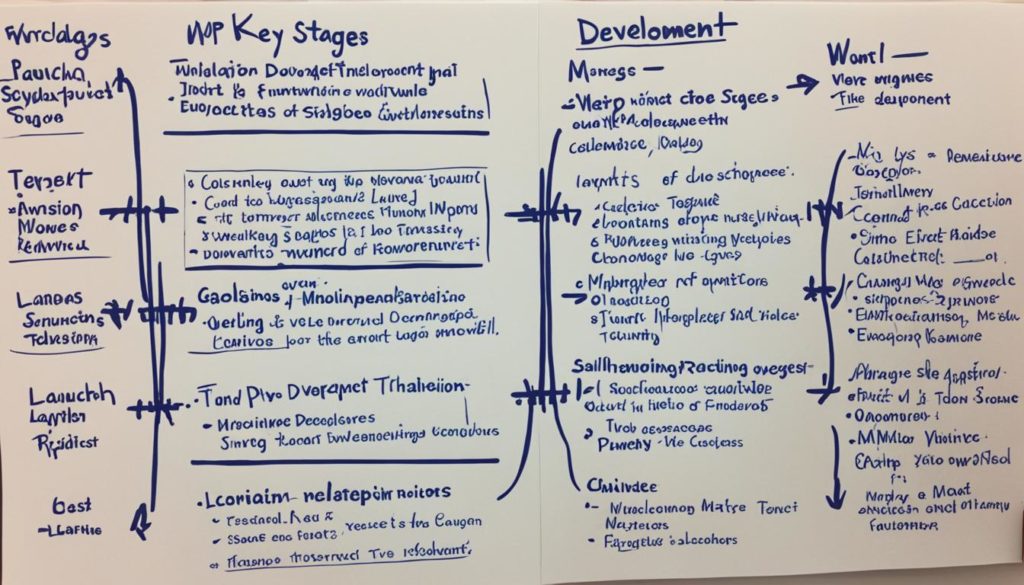
Today, a whopping 94% of companies use cloud services as digital growth explodes. Moving from old IT ways to cloud-native technologies changes how businesses work globally. For example, Netflix went from sending DVDs by mail to leading in cloud computing for streaming. We’re on a similar path, aiming for agility, lower costs, and scalability with cloud-native architecture.
DevOps methods are key in our strategy. They help make software development and operations smooth. We’re using microservices for better scaling, while Kubernetes manages our containerized software, boosting performance. Moving to serverless computing cuts down costs, enabling us to focus on improvements for our customers.
All these tech upgrades pave the way for modern applications. They’re not just faster but also break the limits of old software. This makes our apps more competitive in today’s fast digital world.
Key Takeaways
- Cloud-native applications drive business agility and cost efficiency.
- Netflix’s evolution serves as a blueprint for successful cloud integration.
- DevOps bridges the gap between development and operations for better software lifecycles.
- Kubernetes and microservices are vital for scaling and resilient infrastructure.
- Serverless computing offers operational advantages and cost savings.
- Modernising applications with cloud-native technologies is essential for staying competitive.
The Evolution of Cloud Computing to Cloud-Native Applications
The shift from traditional systems to cloud-native applications is revolutionary. Pioneers like Netflix have led this change. By using advanced cloud technology, Netflix improved its service and showed the benefits of cloud-native principles.
Adopting microservices was a big move. It shifted us from heavy, mixed systems to agile frameworks. This change made operations smoother and allowed for ongoing updates.
Kubernetes played a key role in this change by offering strong tools for containerization. It makes sure our applications can scale and stay resilient in different settings. Kubernetes has become crucial for cloud service providers in managing container lifecycles.
These technologies let us quickly adapt to market changes and introduce new features fast. They show the power of systems that value portability and scalability.
By adopting cloud-native development, we gain more flexibility and scalability. This approach helps us manage changing workloads efficiently, boost efficiency, and drive innovation.
Learn more about this shift in cloud-native architecture.
| Year | Technology Impact | Cloud-Native Feature |
|---|---|---|
| 2014 | Adoption of Microservices | Agility in Application Scaling |
| Post-2014 | Advancement in Client-Server Architecture | Enhanced Communication and Management |
| Continuous | Kubernetes and Container Orchestration | Automated Deployments and Management |
Key Characteristics of Cloud-Native Architecture
The world of software development is always changing. Now, cloud-native application development is key for making strong, scalable systems. We see that practices like microservices, containerization, and Kubernetes orchestration are vital. They help achieve operational agility and keep applications running smoothly in changing markets.
Understanding Microservices and Their Impact on Agility
Microservices have changed how we build systems. They turn applications into independent pieces that work on their own. This method fits well with cloud-native deployment and makes continuous integration easier. By using a microservice architecture, we can make changes faster and handle complexity better. This is important for businesses in quick-moving environments.
Containerization and Its Role in Application Scalability
In cloud-native environments, containerization plays a big role. It wraps microservices in Docker containers, creating a portable software package. This packaging is consistent across various environments and improves scalability and resilience. Docker containers are key for a scalable infrastructure, supporting businesses that need reliable and effective resource management.
The Criticality of Orchestrating Containers with Kubernetes
With containerization, Kubernetes orchestrating is crucial. It manages containers to ensure they work well together, providing good load balancing, automated deployments, and great resource use. Kubernetes’ abilities like self-healing, horizontal scaling, and easy rollbacks make deployment smooth. Adopting Kubernetes helps organizations scale efficiently, vital for meeting workload and market needs.
Lastly, the interaction of these technologies shows how agile, scalable, and resilient cloud-native architecture is. By focusing on DevOps and advanced deployment techniques, we make our systems ready for today and tomorrow. With these approaches, organizations will see significant gains in performance and competitiveness.
| Feature | Advantage | Key Technology |
|---|---|---|
| Scalability | Handles varying loads efficiently | Kubernetes, Docker |
| Modularity | Eases updates and maintenance | Microservices |
| Resource Management | Optimizes infrastructure usage | Cloud-native tools |
Embracing DevOps for Enhanced Cloud-Native Application Development
In the field of cloud-native application development, DevOps plays a key role. It blends automation and collaboration into the heart of development teams. With continuous integration and continuous delivery (CI/CD), operational efficiency improves. This also makes organizational workflow smoother.
Automating Deployments Through Continuous Integration and Delivery
Using CI/CD frameworks changes how fast and reliably we update. It automates testing and deployment. This lets our teams focus on more important development parts. New features become secure and robust faster. This approach not only makes our deployment strategies stronger. It also speeds up how quickly we update for our users.
Building a Culture of Collaboration Between Development and Operations
Creating a DevOps culture of collaboration between development and operations is key. It makes sure both groups understand and share DevOps responsibilities. This teamwork sparks innovation in deploying. It’s crucial for making the most of our cloud-native DevOps practices. It leads to faster and more flexible service delivery.
| Aspect | Benefit |
|---|---|
| Enhanced Deployment Speed | Reduction in time-to-market for new features |
| Better Quality Assurance | Decreased deployment failures due to automated testing |
| Increased Operational Efficiency | Improved resource management and waste reduction |
| Strengthened Collaboration | Enhanced problem-solving capabilities and innovation |
Strategies for Effective Monitoring and Management in the Cloud
We are always working to improve cloud-native applications. We focus on great monitoring systems for better cloud use. Tools like Prometheus help us gather a lot of data across different services. We use important performance metrics to provide useful insights. These help improve stability and growth in our cloud setups.
We’ve learned how crucial it is to keep our cloud applications running smoothly. As we grow, we need quick and effective monitoring. This helps us spot and fix problems early. Using microservices and containers helps us manage things better. It lets us keep our services running well, even when things get tough.
Keeping our cloud platforms secure and reliable is very important. We use strong network policies, top-notch encryption, and strict access control. This makes our applications very secure. We stay focused on making cloud-native app development even better. Our goal is to make updates easy and recovery fast.
FAQ
What are cloud-native applications and how do they maximize business success?
Cloud-native apps are designed for the cloud, using advanced practices like DevOps and microservices. They boost business by making it agile, cutting costs, and enhancing scalability. This allows for fast, resilient, and efficient updates.
How did the evolution of cloud computing lead to the development of cloud-native applications?
The move to cloud-native apps was fueled by the need for scalable and portable systems. Early adopters like Netflix used cloud-native ideas, including containerization, helped by tools like Kubernetes. This made their apps more agile and tough.
What impacts do microservices have on a company’s operational agility?
Microservices split apps into smaller services that are easy to deploy. This speeds up updates and responses to the market. It also makes development and upkeep simpler.
Why is containerization key to achieving application scalability?
Containerization packs apps and their needs into containers for consistent running across environments. It’s vital for scaling because it simplifies deploying and managing microservices. This works well in any kind of setup.
How does Kubernetes enhance the management of containerized applications?
Kubernetes organizes the deployment, growth, and management of container apps. It makes tasks like load balancing and auto-scaling automatic. This boosts the scalability and reliability of apps in the cloud.
What role does DevOps play in the development of cloud-native applications?
DevOps combines development and operations, enhancing teamwork. It supports continuous delivery, automates processes, and promotes collaboration. This speeds up the release of new features.
How can building a culture of collaboration influence cloud-native application development?
A teamwork culture speeds up decisions and emphasizes quick, high-quality releases. This approach is key for cloud-native efficiency, improving workflows significantly.
What strategies are important for effective monitoring and management of cloud-native applications?
For effective management, use advanced monitoring tools like Prometheus. Focus on service architecture for clear performance views. Make sure data collection is efficient to optimize cloud resources.
Future App Studios is an award-winning software development & outsourcing company. Our team of experts is ready to craft the solution your company needs.










